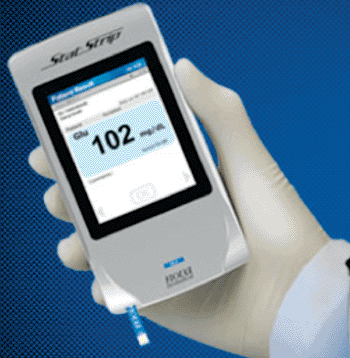Better Blood Glucose Monitor Evaluated for Burn Care
By LabMedica International staff writers
Posted on 18 Sep 2013
Glucose monitoring systems (GMS) with an autocorrect feature can detect red blood cells hematocrit, vitamin C, and other common interferents in burn patients' blood.Posted on 18 Sep 2013
Traditional hospital laboratory testing uses plasma samples devoid of red blood cells, so it remains the most accurate method for measuring blood glucose levels. However, the newer autocorrecting devices use less blood, and produce results in just five seconds, as opposed to approximately 10 to 20 minutes for laboratory testing.

Image: StatStrip Glucose Monitor (Photo courtesy of Nova Biomedical).
A multidisciplinary team at the University of California (Davis, CA, USA) conducted a prospective, observational study followed by a pilot randomized controlled trial. Sixty remnant arterial blood samples were collected to evaluate hematocrit and ascorbic acid effects on accuracy paired against a plasma glucose reference. Another 12 patients were enrolled for a control trial.
The team compared an autocorrecting modified glucose oxidase-based GMS (GMS1; StatStrip Glucose; Nova Biomedical, Waltham, MA, USA) versus a noncorrecting glucose dehydrogenase-based GMS (GMS2; AccuChek Advantage; Roche Diagnostics, Indianapolis, IN, USA). GMS1 incorporates a novel four-well gold biosensor that autocorrects for hematocrit, oxidizing substances, and oxygen tension effects. GMS2 is the current device used for routine care at the institution. The hospital clinical chemistry laboratory analyzer (Synchron LX20, Beckman Coulter; Brea, CA, USA) served as the plasma glucose-reference method. All three systems measure glucose via electrochemical techniques.
An inversely proportional relationship between GMS2 results and hematocrit was observed. In contrast, GMS1 was unaffected by hematocrit. Automatic GMS hematocrit correction reduced glycemic variability, insulin rates, and hypoglycemic events. However, patients at risk of hematocrit and vitamin C interferences, especially burn patients receiving high dose vitamin C therapy, will be tested with the hospital's clinical chemistry laboratory analyzer for glucose levels in the future.
Nam K. Tran, PhD, MS, the lead author said, “Many glucose monitoring systems may not adequately correct for interferents in the blood of burn patients. As a result, an inaccurate reading increases the potential for an insulin overdose. Our study showed that using a device that autocorrects for interferents can produce more accurate blood glucose measurements, which can improve insulin dosing and glucose control." The study was published on September 2, 2103, in the Journal of Burn Care Research.
Related Links:
University of California, Davis
Roche Diagnostics
Nova Biomedical













